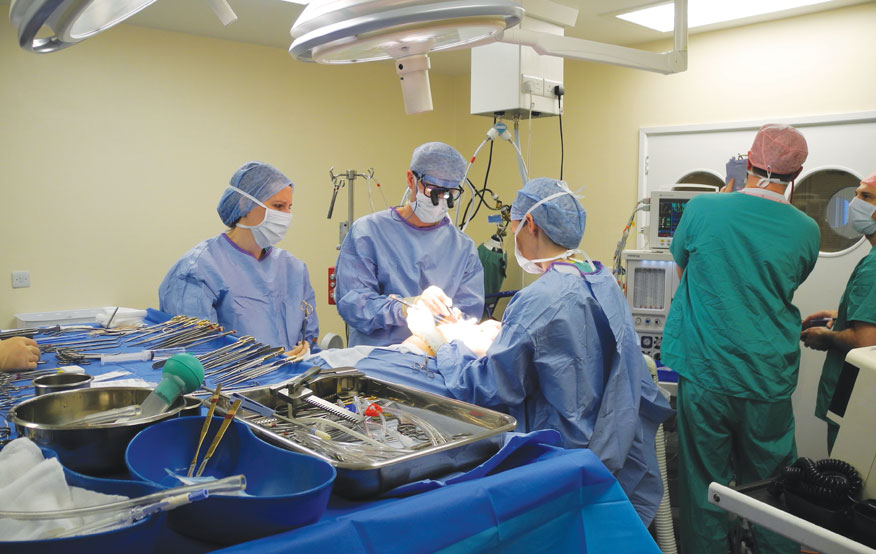Cardiothoracic Surgery Capacity Multiplies
Clinical Connections – Spring 2017
The expansion of RVC Small Animal Referrals’ cardiothoracic surgery team is set to quadruple the number of canine mitral valve surgeries performed.
One of the most prevalent heart defects in dogs, mitral valve disease is still primarily managed medically, though for humans with mitral valve leakage, surgery is the standard therapy. The RVC is one of a few centres in the world to perform the procedure on dogs.
Dan Brockman, Professor of Small Animal Surgery, first performed the first open heart surgery at the RVC in 2005, and has worked alongside human cardiac surgeons and overseas veterinary surgeons to expand what the RVC can offer referral clients.
The RVC’s mitral valve programme has been supported by a team of pioneering clinicians from Japan, who have come over several times to help Professor Brockman operate. A perfusionist from the NHS has also been involved with previous open heart surgeries. The expansion of the RVC team allows the service to carry out more surgeries without having a reliance on visiting clinicians.

The new roles are Cardiothoracic Surgery Fellow, Cardiothoracic Perfusion Fellow and Cardiothoracic Theatre Nurse and Surgery Coordinator. The development enables the RVC to dedicate more time to screen animals to establish which dogs are good candidates for surgery, and to create a more structured mechanism for post-operative follow-up care.
The roles have been funded by The Tailwaggers Trust. The Trust was a long-term supporter of the RVC, dating back to the 1930s, but it sadly ceased operations last year. A previous donation will fund the three new roles for the first two years. The development should enable the number of surgeries for mitral valve disease at the RVC to increase from around one each month to one a week ultimately, should demand exist.
Commenting on the scale of the problem of canine mitral valve disease and the benefits of making surgery available to more dogs, Professor Brockman said: “We are very keen to take all sorts of both congenital and acquired heart defects but what we suspected, and what has been shown quite clearly, is between the number of dogs with mitral valve disease out there is huge. Therefore the demand for surgery is similarly very high. In humans, a leaking mitral valve is a not a medical condition at all but a surgical condition. Now that we can offer surgery, some of these dogs that have had a bout of heart failure, and we would expect to pass away within a year, can have a much better quality of life as well as a longer life.
“Not only can we offer a better quality of life for the dogs, as it improves their ability to exercise, we can also offer a better quality of life for owners. Owners of dogs with mitral valve disease often have had to change their lifestyle to make sure they can give the dog the medication it requires at the necessary time intervals. Therefore, if we can reduce the number of medications and the frequency of medications that these animals receive, then the owners really benefit as well.”
Alluding to the surgical challenges, Professor Brockman added: “These are some of the most interesting but also challenging patients to operate on. We steered clear of mitral valve disease surgical patients until we had the fundamentals of cardio-pulmonary bypass under control. Performing a repair of the mitral valve is not a straightforward thing. There’s a very steep learning curve and each patient is slightly different. Simplistically, taking a diseased valve out and replacing it with an artificial valve that we know works perfectly well would be a much easier thing to do than attempting to repair a valve. The problem is dogs don’t tolerate artificial valves very well at all, in fact, they form blood clots on them very quickly.
“Therefore we repair the valve, using a combination of techniques – some of which replace the suspensory apparatus (chordae tendinee) of the valve with some Gore-Tex suture material. The other component is to place an annuloplasty to bring the enlarged valve annulus down to a normal size so the valve leaflets can meet properly.”
Although the RVC team has, inevitably, operated on the most severely affected animals, the evidence from human medicine shows that the earlier you intervene the better the long-term outcome. The RVC team anticipates that, over time, the patient population will shift from being dogs with end-stage disease to those that have not had a bout of failure but are known to have bad valves. Therefore valves can be repaired before many of the secondary degenerative cardiopulmonary events have happened.
The educational benefit of expanding the RVC’s mitral valve programme is many fold. Undergraduate students will see more dogs with mitral valve disease and, as a result, will gain a better understanding of how to treat it medically. In terms of postgraduate clinical training, scholars will be exposed to the advanced cardiology aspects, the advanced surgical aspects and the critical care components of the care these animals need, which will develop key transferable clinical skills.
Vets can refer dogs with mitral valve disease by either contacting the cardiology service or Dan Brockman or Poppy Bristow in the surgery team, via the referrals line (01707 666365).
Sign up to get Clinical Connections in your inbox rvc.ac.uk/clinical-connections
